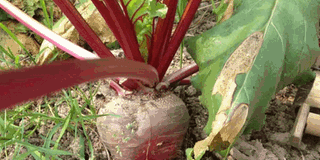Prime
Ways to increase beetroot production

Beetroot plant
What you need to know:
- Beetroot is grown mainly through seeds. The seeds are sown at a depth of about 1.5 to two centimetres. There should be a distance of at least 35 centimetres between each row. Continuous watering is essential for the efficient and effective growth.
Beetroot is a herbaceous plant grown for its edible root. The plant usually stands with a long central root and has a rose of leaves growing on the stem. The leaves are oval, arranged alternately on the stem, and grow 20 to 40 centimetres. The roots are usually red. Beetroot is easy to grow, takes up little space, and is excellent for beginners.
Types of beetroot
Vegetable agronomist, Daniel Muyingo says there are different types of beetroots, and each has its unique characteristics starting from size, shape, and colour. Some popular types of beetroot include the red table beet- which produces edible greens in 35 days then a cylindrical root a month later, white, orange and golden beet- these are praised for their mild nutty flavour.
Beetroot is a very simple vegetable that suffers from very few pests and diseases. Beet root needs fertile soil that adds a lot of decomposed organic matter.
“Beetroot prefers a place in full sun but you have to improve the soil by digging in well-decomposed manure,” says Muyingo.
He adds that while preparing the garden you have to remove stones as they can affect the excellent growth of the roots because beetroot need smooth ground where they can enlarge without blockage.
Soil surface
Muyingo says it is necessary to release the soil in a good field by ploughing it well.
A very important part of soil preparation is the removal of nuts. It is advisable to dig the ground to a depth of 15 to 20 centimetres.
“Abundant water is essential for seed germination. Water the plant daily for growth. But avoid over-watering as it can produce more leaves and reduce the size of the roots. After the plants ripen, water them every 10-14 days,” he says.
Type of soil
Muyingo says while planning to plant beetroot you have to make sure you choose the best soil which can give out good production.
If the soil is compact or contains rocks or other debris, it can hinder the root growth or damage them.
“Before planting, ensure the soil you are planting in is loose and free of obstructions, deep and well-drained loamy soil or sandy loams are best for beetroot production. Clay soil is not recommended,” he says.
“Farmers must know that sweet beets are produced from organic fertilisers, manure, and homemade fertilisers, therefore chemical fertilisers are not allowed because they affect the growth,” he says.
Planting and spacing
Beetroot farmers should use 40,000 plants per acre of land using only one plant per hill. Beets are grown from a small pea-sized cluster of seeds.
Each cluster contains many small true seeds. You have to soak the clusters of seeds for 12 hours before sowing to help germination.
Spread clusters one inch deep and one inch apart badges can be broadcast. Spread the seeds lightly on a bed 15 to 18 inches (38-45 cm). The seeds will need to be watery and the plants will grow in bunches.
Use small scissors to thin, successful plants to four to six inches when they are three inches high.
Alternatively, you can gently separate the young plants and place the different plants in a nearby row.
Space rows are 12 to 18 inches apart and they are cut like tinny herbs of salads.
Inter-cropping
Intercropping is the practice of growing two or more crops in proximity. You can intercrop beetroot with onions, cabbage and lettuce. Intercropping helps you on pollination, control pests and increase productivity.
Diseases
Muyingo says the common symptoms of the diseases affecting the beetroot plant is the yellow colour leaves which are the first sign of trouble.
“It is essential to understand what can cause your beet leaves to turn yellow to prevent the problem from spreading before it causes damage or failure to the plant to grow well,” he says.
Agronomy
Muyingo adds that beetroot needs moisture for best growth and watering promote the growth of good quality roots and prevent ring formation in the roots. Soil moisture can be preserved by applying mulch around the plants.
“In addition to moisture, beetroot also need a proper supply of nutrients, especially phosphorus. Apply complete fertiliser to the plant to ensure maximum growth. Lightly cultivate and remove weeds around the plant so as not to damage the developing roots,” says Muyingo.
Challenges
Muyingo says normally beetroot faces some common problems such as poor growth, colourless leaves, insect infestation, disease, and abnormal growth. Some of these problems are more troubling than the danger to your plants.
“Insects, such as aphids and flea beetles, can damage leaves to such an extent that it affects beetroot growth. Similarly, diseases such as Cercospora leaf spot can put stress on beetroot plants, as a result of which beetroots will become smaller than they are. Sometimes leaves bend and new shoots to deformed, resulting in reduced root production,” he says.
Irrigation
Muyingo adds that irrigation should be done first after sowing. During rainy season irrigation is done every six to seven days; irrigation is given only when required in the rainy season.



